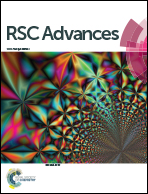Surface imprinting of a g-C3N4 photocatalyst for enhanced photocatalytic activity and selectivity towards photodegradation of 2-mercaptobenzothiazole†
Abstract
In the present work, based on Fe3O4/g-C3N4 as the support, 2-mercaptobenzothiazole (MBT) as the template molecule, and pyrrole as the functional monomer, we synthesized magnetic conductive imprinted photocatalysts (MCIPs) that were significantly efficient and stable through a suspension polymerization method. Moreover, the MCIPs not only exhibited a higher photodegradation capacity for MBT under visible light irradiation, but also possessed good selectivity. The specific surface areas of the resultant MCIPs were approximately four times that of pure g-C3N4. Furthermore, the results indicated that h+ was the major reactive species in the photocatalytic reaction system. The photodegradation mechanism was also discussed by analyzing the mass spectrum (MS), and the results demonstrated that MBT was degraded to H2O, CO2 and other small molecules, step by step. In addition, after five cycles, the MCIPs still showed high photocatalytic efficiency, indicating that the as-prepared MCIPs had excellent photochemical stability and good prospects for application in water treatment.


 Please wait while we load your content...
Please wait while we load your content...